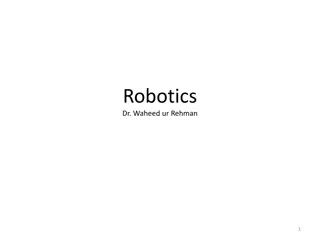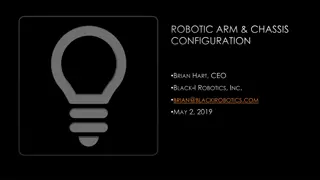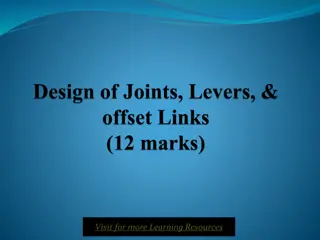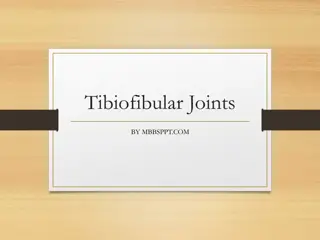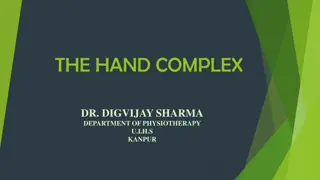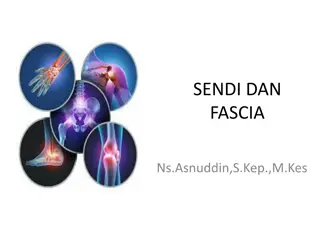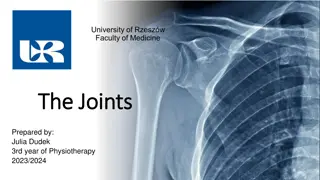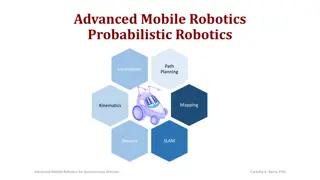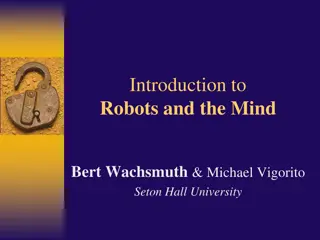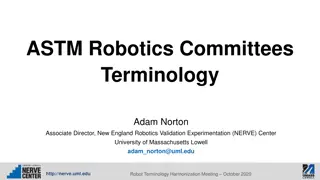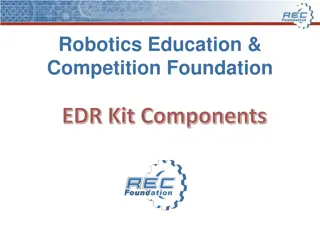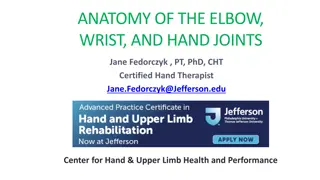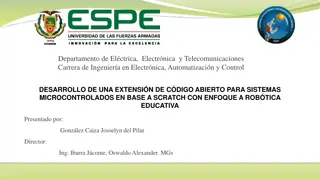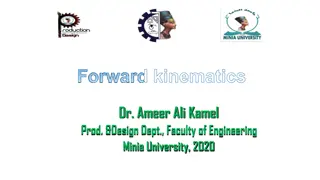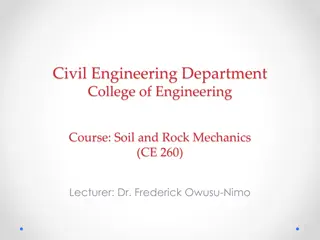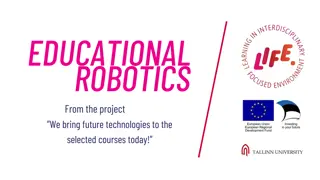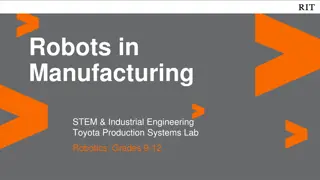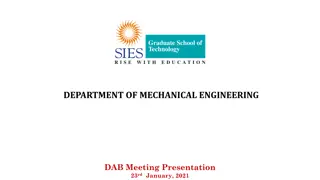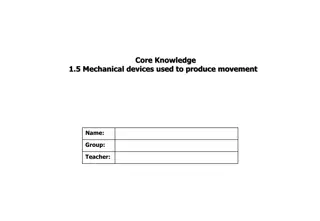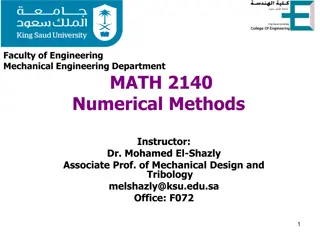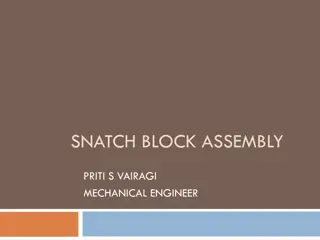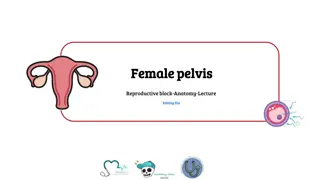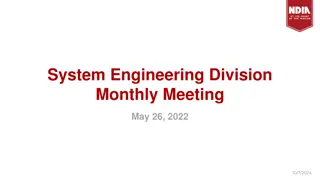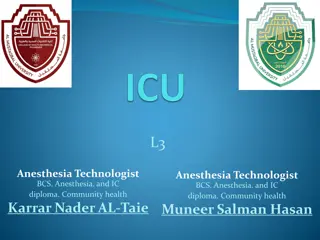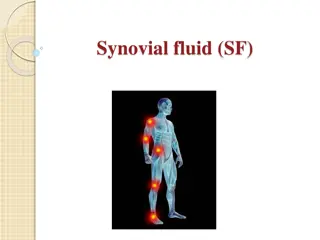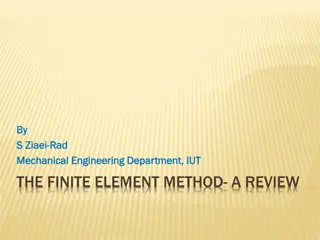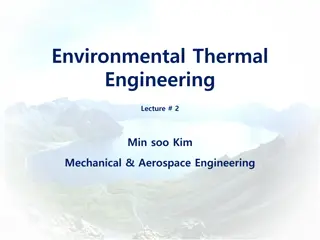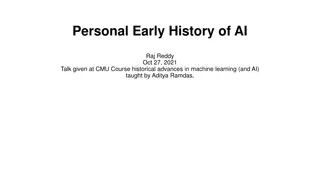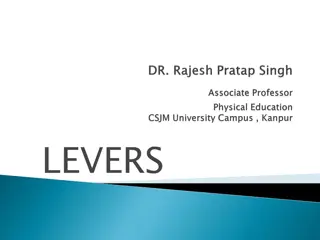Understanding Robotics: Components, Joints, and Manipulators in Mechanical Engineering
Explore the world of robotics through an in-depth analysis of the key components, mechanical elements, manipulator joints, end-effectors, and types of robots used in production engineering and mechanical design departments. Learn about joints, links, degrees of freedom, and how robot manipulators are structured to perform precise tasks efficiently.
Uploaded on Oct 07, 2024 | 0 Views
Download Presentation

Please find below an Image/Link to download the presentation.
The content on the website is provided AS IS for your information and personal use only. It may not be sold, licensed, or shared on other websites without obtaining consent from the author. Download presentation by click this link. If you encounter any issues during the download, it is possible that the publisher has removed the file from their server.
E N D
Presentation Transcript
El-Minya High Institute Mechanical Engineering Department-Mechatronics Robotics Analysis Robotics Analysis Dr. Ahmed Rashed Ahmed
Key Components Key Components Production Engineering and Mechanical Design Department Faculty of Engineering - Minia University
Mechanical Elements Mechanical Elements Link3 Joint3 End of Arm Manipulator consists of joints and links Joints provide relative motion Links are rigid members between joints Various joint types: linear and rotary Each joint provides a degree-of-freedom Most robots possess five or six degrees-of-freedom Robot manipulator consists of two sections: Body-and-arm for positioning of objects in the robot's work volume Wrist assembly for orientation of objects Link2 Link1 Joint2 Joint1 Link0 Base Production Engineering and Mechanical Design Department Faculty of Engineering - Minia University
Manipulator Joints Manipulator Joints Translational motion Linear joint (type L) Orthogonal joint (type O) Rotary motion Rotational joint (type R) Twisting joint (type T) Revolving joint (type V) Production Engineering and Mechanical Design Department Faculty of Engineering - Minia University
Uses the joint symbols (L, O, R, T and V) to designate joint types used to construct robot manipulator Separates body-and-arm assembly from wrist assembly using a colon (:) Example: TLR Production Engineering and Mechanical Design Department Faculty of Engineering - Minia University
end end- -effector effector Many manipulators will be a sequential chain of links and joints forming the arm with multiple DOFs concentrated at the wrist Production Engineering and Mechanical Design Department Faculty of Engineering - Minia University
Types of Robots Types of Robots Robot Manipulators Mobile Manipulators mm Production Engineering and Mechanical Design Department Faculty of Engineering - Minia University
Robot Manipulators Robot Manipulators Open chains robot (serial robot) closed chains robot (Parallel robot) Production Engineering and Mechanical Design Department Faculty of Engineering - Minia University
Serial robot Serial robot Serial manipulators are the most common industrial robots. They are designed as a series of links connected by motor-actuated joints that extend from a base to an end-effector. Advantages: large workspace with respect to the size Disadvantages: The low stiffness inherent to an open kinematic structure, errors are accumulated and amplified from link to link, the fact that they have to carry and move the large weight of most of the actuators, and the relatively low effective load that they can manipulate. Production Engineering and Mechanical Design Department Faculty of Engineering - Minia University
Parallel robot Parallel robot some of the links will form a closed chain with ground Advantages: Motors can be proximal: less powerful, higher bandwidth, easier to control Disadvantages: Generally less motion, kinematics can be challenging Production Engineering and Mechanical Design Department Faculty of Engineering - Minia University
Mobile robot Mobile robot Aerial Robots Wheeled mobile robots Legged robots Underwater robots Humanoid Production Engineering and Mechanical Design Department Faculty of Engineering - Minia University
Workspace Workspace The reachable space the tool can achieve Reachable workspace Dextrous workspace (a) spherical (b) SCARA (c) cylindrical (d) Cartesian Production Engineering and Mechanical Design Department Faculty of Engineering - Minia University
Common configurations Common configurations (a) Cartesian geometry(PPP) Production Engineering and Mechanical Design Department Faculty of Engineering - Minia University
Production Engineering and Mechanical Design Department Faculty of Engineering - Minia University
(b) cylindrical geometry(RPP) Production Engineering and Mechanical Design Department Faculty of Engineering - Minia University
Production Engineering and Mechanical Design Department Faculty of Engineering - Minia University
(c) polar/spherical geometry(RRP) Production Engineering and Mechanical Design Department Faculty of Engineering - Minia University
Production Engineering and Mechanical Design Department Faculty of Engineering - Minia University
(d) revolute geometry/articulated arm(RRR) Production Engineering and Mechanical Design Department Faculty of Engineering - Minia University
Production Engineering and Mechanical Design Department Faculty of Engineering - Minia University
Why Use Robots? Why Use Robots? Increase product quality Superior Accuracies (thousands of an inch, wafer-handling: micro-inch) Repeatable precision Consistency of products Increase efficiency Work continuously without fatigue Need no vacation Increase safety Operate in dangerous environment Need no environmental comfort air conditioning, noise protection, etc Reduce Cost Reduce scrap rate Lower in-process inventory Lower labor cost Reduce manufacturing lead time Rapid response to changes in design Increase productivity Value of output per person per hour increases Production Engineering and Mechanical Design Department Faculty of Engineering - Minia University
Applications of robots Applications of robots Robot Manipulators Assembly, automation Field robots Military applications Space exploration Service robots Cleaning robots Medical robots Entertainment robots Production Engineering and Mechanical Design Department Faculty of Engineering - Minia University


